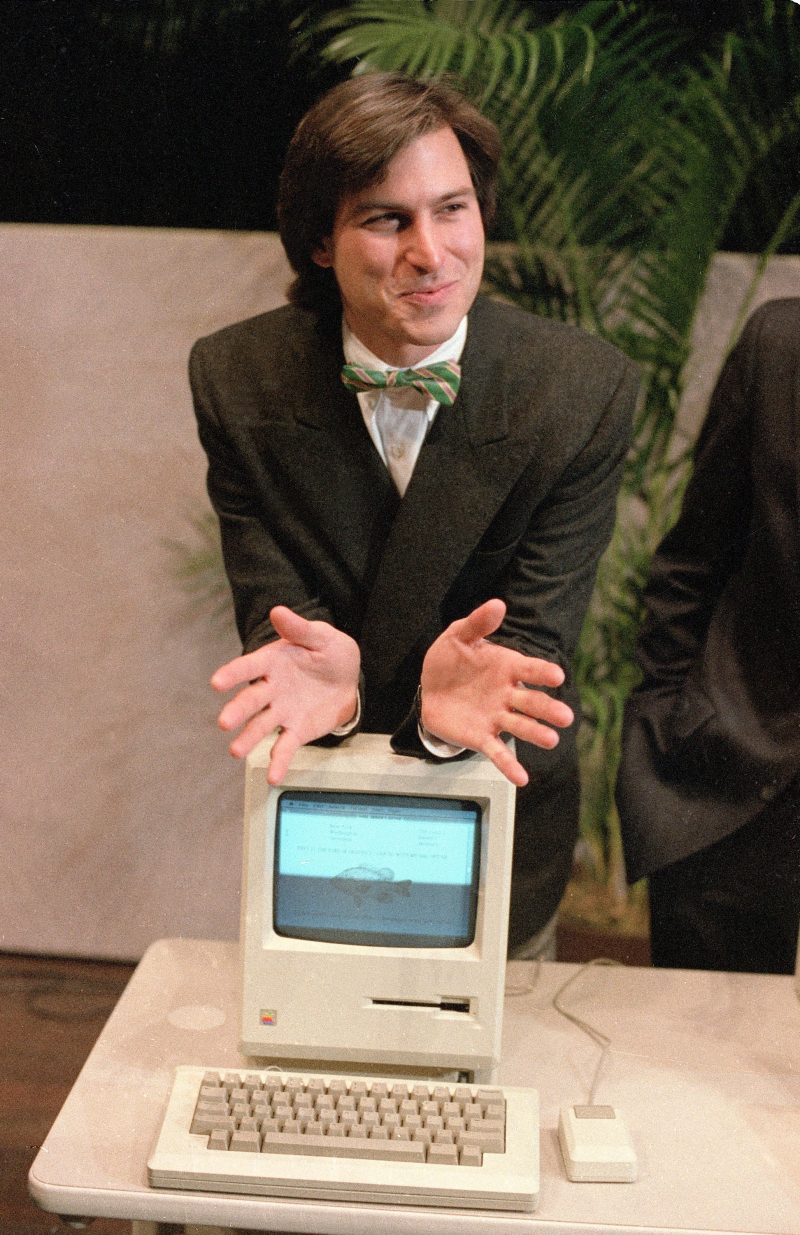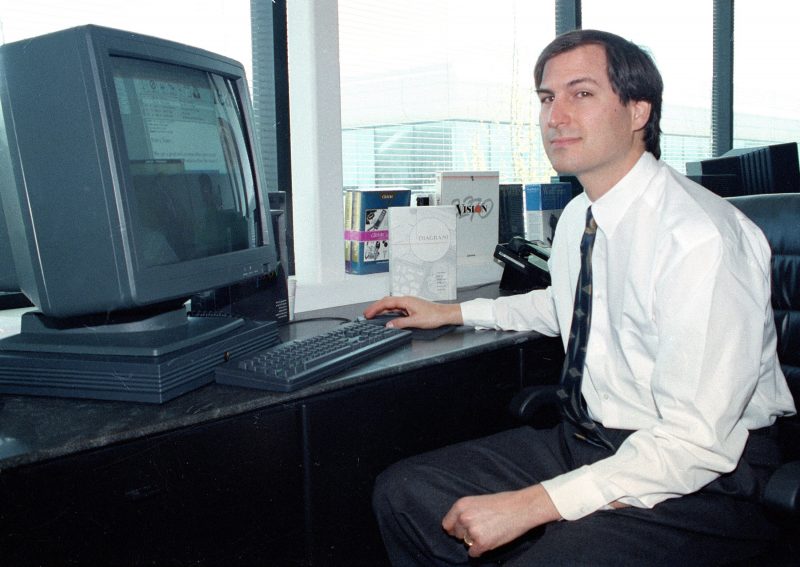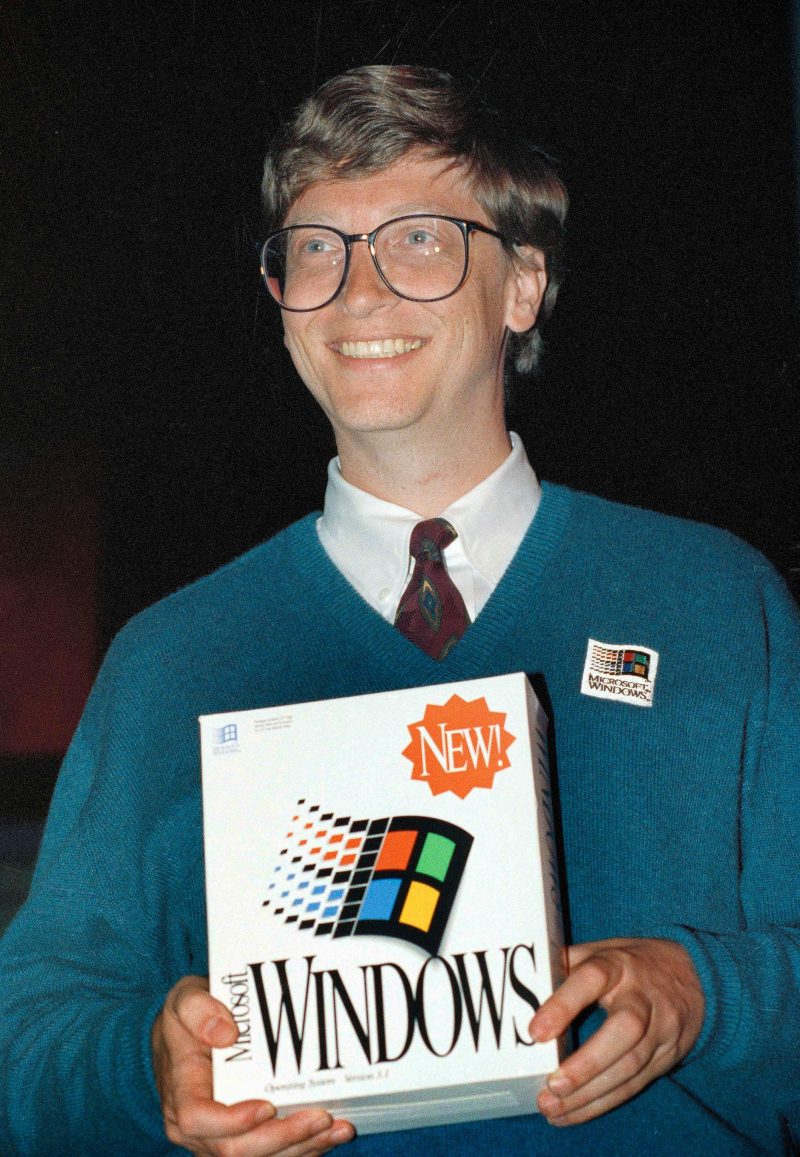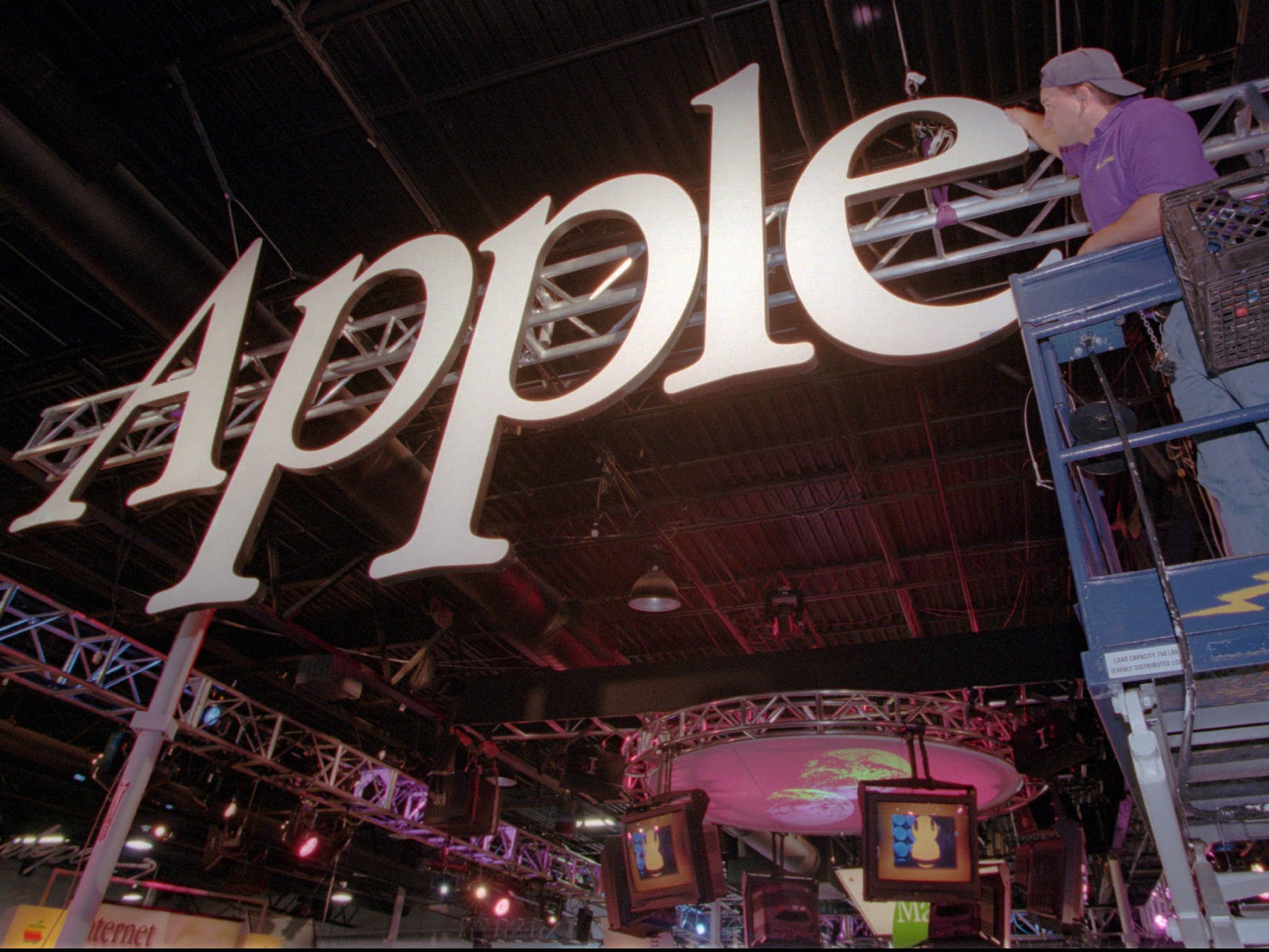- Apple became a $2 trillion company on Wednesday.
- But the iPhone-maker almost didn’t make it this far – it struggled in the ’90s until Steve Jobs returned as the company’s CEO.
- Apple has weathered hits and flops over the years, from the launch of the influential Apple II to the misguided Newton MessagePad.
- But these days, Apple is on top of the consumer electronics market, thanks at first to devices like the iMac and the iPod, and later, to the iPhone.
- Visit Business Insider’s homepage for more stories.
Apple just reached a $2 trillion market cap, a milestone made even more significant when you consider that Apple almost didn’t get the chance to make it this far.
When Steve Jobs took over as CEO of Apple in 1997, the company had been struggling to find its legs in a market increasingly dominated by Microsoft and its partners.
Indeed, Michael Dell himself once quipped that if he were in Jobs’ shoes, he’d shut Apple down and return the money to the shareholders.
Here’s a look into the history of Apple in photos, from its inception, through its hard times, to the triumphant return of Jobs.
Apple was cofounded on April 1, 1976, by Steve Jobs and Steve Wozniak in Los Altos, California.

There was a third cofounder, too: Ronald Wayne. Jobs brought Wayne on board to provide business guidance for the two young cofounders. Wayne sketched the first Apple logo by hand.

Source: Business Insider
Wayne ended up leaving the company before it was even officially incorporated. He took an $800 check for his shares in the company.

Source: Business Insider
Apple's first "office" was the garage at Jobs' parents' house.

Source: Business Insider
The company's first product was the Apple I, which was just a motherboard with a processor and some memory, intended for hobbyists. Customers had to build their own case and add their own keyboard and monitor, as seen in the picture. It sold for $666.66 — seriously. The Apple I was invented by Wozniak, who also hand-built every kit.

Source: CNET
Meanwhile, Jobs handled the business end, mainly trying to convince would-be investors that the personal computer market was primed to explode. Eventually, Jobs would bring in Mike Markkula, who made a crucial $250,000 angel investment and came to work for Apple as employee No. 3, with a one-third share in the company.

Source: The New York Times, CNBC
Apple would officially incorporate in 1977, thanks to guidance from Markkula. A man named Michael Scott (no, not the one from "The Office") was brought in at Markkula's suggestion to serve as the company's first president and CEO. The thought was that Jobs was too young and undisciplined to serve as CEO.

Source: Business Insider
1977 also saw the introduction of the Apple II, the personal computer designed by Wozniak that would go on to take the world by storm.

Source: National Museum of American History
The Apple II's killer app was VisiCalc, a groundbreaking spreadsheet software that propelled the computer ahead of market leaders Tandy and Commodore. With VisiCalc, Apple could sell the Apple II to the business customer.

Source: National Museum of American History
By 1978, Apple would actually have a real office, with employees and an Apple II production line.

Source: Business Insider
The Xerox PARC lab is world-famous for its technological accomplishments, which include the laser printer, mouse, and ethernet networking. In 1979, Apple engineers were allowed to visit the PARC campus for three days, in exchange for the option to buy 100,000 shares of Apple for $10 a share.

Source: Newsweek
In 1980, Apple released the Apple III, a business-focused computer that was supposed to compete with the growing threat of IBM and Microsoft. But the Apple III was only a stopgap, and Xerox PARC had gotten the young Jobs thinking in a different direction.

Source: Byte Magazine, Newsweek
Xerox PARC convinced Jobs that the future of computing was with a graphical user interface (GUI), like the kind we're used to today.

Jobs spearheaded the effort to equip Apple's next-generation Lisa computer with a GUI, but was bumped from the project thanks to infighting. Lisa was released in 1983 to much fanfare, but disastrous sales - it was too expensive and didn't have enough software support.
Jobs ended up leading the second project, the Apple Macintosh, billed as the most user-friendly computer to date. It would go on to become popular with graphic-design professionals, who liked its visual chops (even though it was in black and white). It was still very expensive, however.

Source: The Guardian
Around the time of the launch of the first Macintosh in 1983, Apple got a new CEO: John Sculley.

Sculley was serving as Pepsi's youngest-ever CEO, but Jobs managed to bring him to Apple with the now-legendary pitch: "Do you want to sell sugared water for the rest of your life? Or do you want to come with me and change the world?"
Source: Forbes
In 1984, Apple would release the TV commercial that would make it a household name. This ad, appropriately called "1984," was directed by Ridley Scott and cost the company $1.5 million. It aired during the third quarter of Super Bowl XVIII, and never again.
Source: Business Insider
This was also when tensions between Jobs and Bill Gates started to run high. Originally, Microsoft was working hard at making software for the Macintosh. But those plans were scuttled in 1983 when Microsoft revealed that it, too, was working on a graphical user interface called Windows.

Source: Business Insider
The Macintosh had strong sales, but not enough to break IBM's dominance. This led to a lot of friction between Jobs — the head of the Macintosh group who liked doing things his own way — and Sculley, who wanted stricter oversight on future products in light of the Lisa disaster and disappointment of the Macintosh. It got to the point that Apple's board specifically instructed Sculley to "contain" Jobs.

Source: Business Insider, Fortune
Things came to a head in 1985 when Jobs tried to stage a coup and oust Sculley — but Apple's board of directors took Sculley's side and removed Jobs from his managerial duties. A furious Jobs quit and went on to found NeXT, a computer company making advanced workstations where he had total control.

Source: Fortune, Business Insider
Wozniak left around the same time in 1985, saying that the company was going in the wrong direction. He sold most of his shares.

Source: CNN
With Jobs gone, Sculley had a free hand at Apple. At first, things seemed great, and Apple introduced its PowerBook laptop and System 7 operating system in 1991. System 7 introduced color to the Macintosh operating system, and would stick around (with updates) until OS X was released in 2001.

Source: Engadget, Cult of Mac
The 1990s would see Apple get into lots of new markets, none of which really worked out. Possibly the most famous Apple flop of the '90s was 1993's Newton MessagePad, which was Sculley's own brainchild. It literally created the market for "personal digital assistants," but it was $700 and did little more than take notes and keep track of your contacts.

Source: Baltimore Sun, Time, MacWorld
But Sculley's longest-lasting mistake was in spending lots of time and lots of Apple's cash on bringing System 7 to the brand-new IBM/Motorola PowerPC microprocessor instead of the dominant Intel processor architecture. Most software was written for Intel processors, plus they got cheaper and cheaper over the years.

Source: Cult of Mac
At the same time, Microsoft's influence was on the rise. Macs offered an excellent, but limited, library of software on expensive computers. Meanwhile, Microsoft was selling Windows 3.0 on cheap, commodity computers.

Source: Microsoft
Between the high-profile flops and the costly decision to move to PowerPC, Apple's board had had enough. After Apple missed on its first quarter earnings in 1993, Sculley stepped down and was replaced as CEO by Michael Spindler, a German expatriate who had been with Apple since 1980.

Source: Washington Post, Los Angeles Times
Spindler had the unfortunate job of following through with Sculley's big PowerPC mistake. In 1994, the first Macintosh running on a PowerPC was released. But Apple's fortunes continued to sag as Windows took off. After acquisition talks with IBM, Sun MicroSystems, and Philips all fell through, Apple's board replaced Spindler with Gil Amelio in 1996.

Source: The New York Times
Amelio's tenure was equally troubled. Under his reign, Apple stock hit a 12-year low (largely because Steve Jobs himself sold 1.5 million Apple shares in a single transaction). Amelio decided to just purchase Jobs' NeXT Computer for $429 million in February 1997 to bring him back to Apple.

On the July 4 weekend that same year, Jobs would stage a boardroom coup and convince Apple's board to install him as interim CEO. Amelio resigned a week later.

Source: The New York Times
1997 would also see the introduction of Apple's famous "Think Different" ad campaign, celebrating famous artists, scientists, and musicians.

Source: Cult of Mac
Under the new era of Jobs' leadership, the company would make nice with Microsoft, which invested $150 million in Apple circa 1997.

Source: CNBC
It was a new era for hardware and software, too. Jobs had Jony Ive spearhead the design of the iMac, an all-in-one computer released in 1998. In 2000, Jobs introduced Mac OS X, based on the operating system from NeXT Computers, finally replacing System 7. And in 2006, Apple finally moved to an Intel-based system architecture.

Apple had two massively influential product releases in the 2000s, beginning with the iPod in 2001. It blew other MP3 players out of the water and radically altered the way we listen to music. The iPod also launched Apple's white earbuds as a status symbol.

Source: Business Insider
But the single biggest victory for Apple — and arguably the world of technology as a whole — was 2007's introduction of the iPhone. When it went on sale, customers lined up outside stores in the US to get their hands on one.

Source: Cult of Mac
Since then, Apple has gone on to release 17 more models and, under CEO Tim Cook — who took over after Jobs' death in 2011 — Apple has introduced new hardware product lines, including the Apple Watch and AirPods.

Source: CNBC
The company has also expanded into services, which has helped fuel Apple's growth as iPhone sales have lagged. Apple now offers its own music- and video-streaming services, its own payments system and credit card, and other subscription offerings in news and gaming.

Source: Business Insider
In August 2020, Apple hit a new milestone: It became a $2 trillion company, just 24 months after reaching the $1 trillion threshold.

Source: Business Insider
